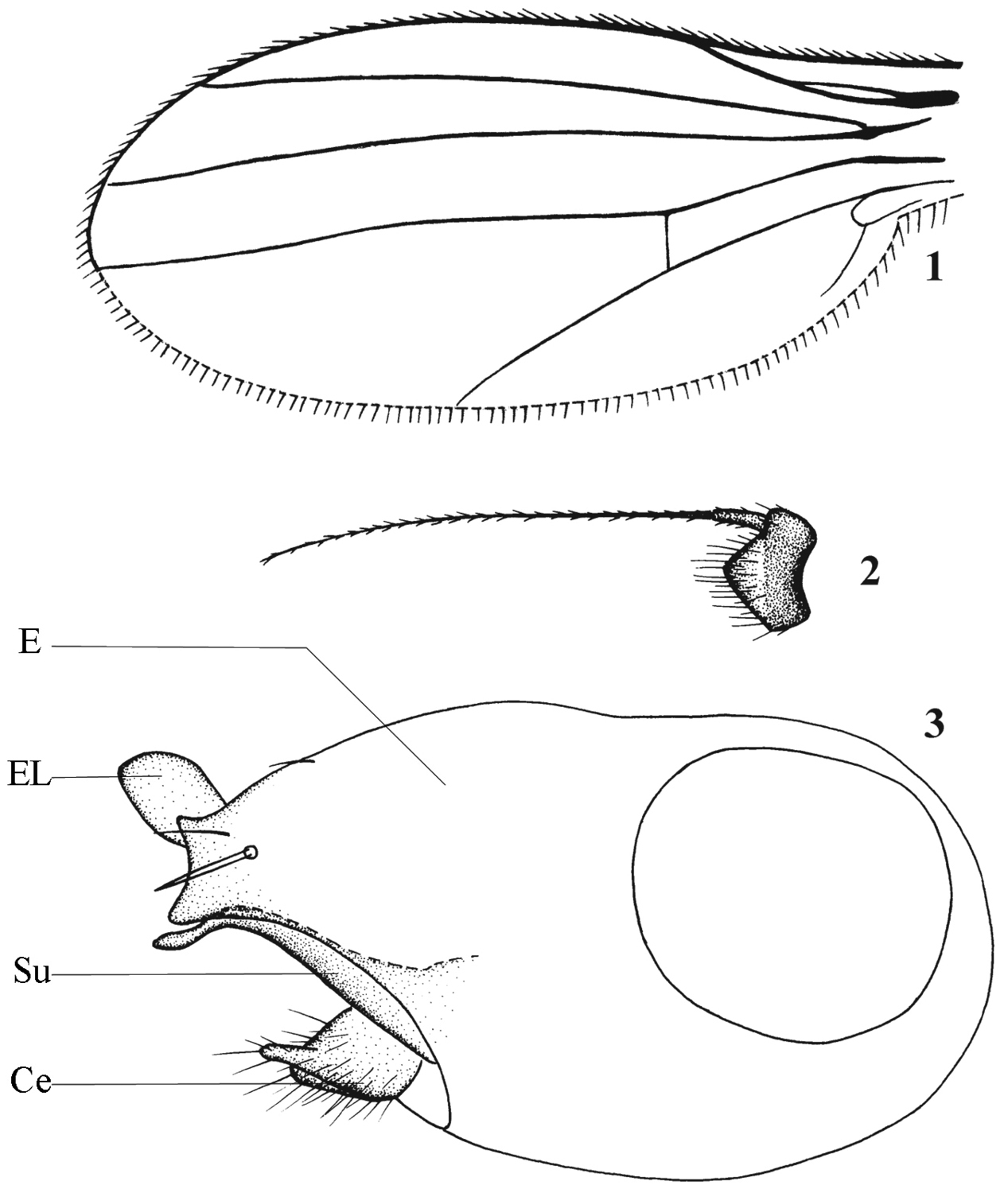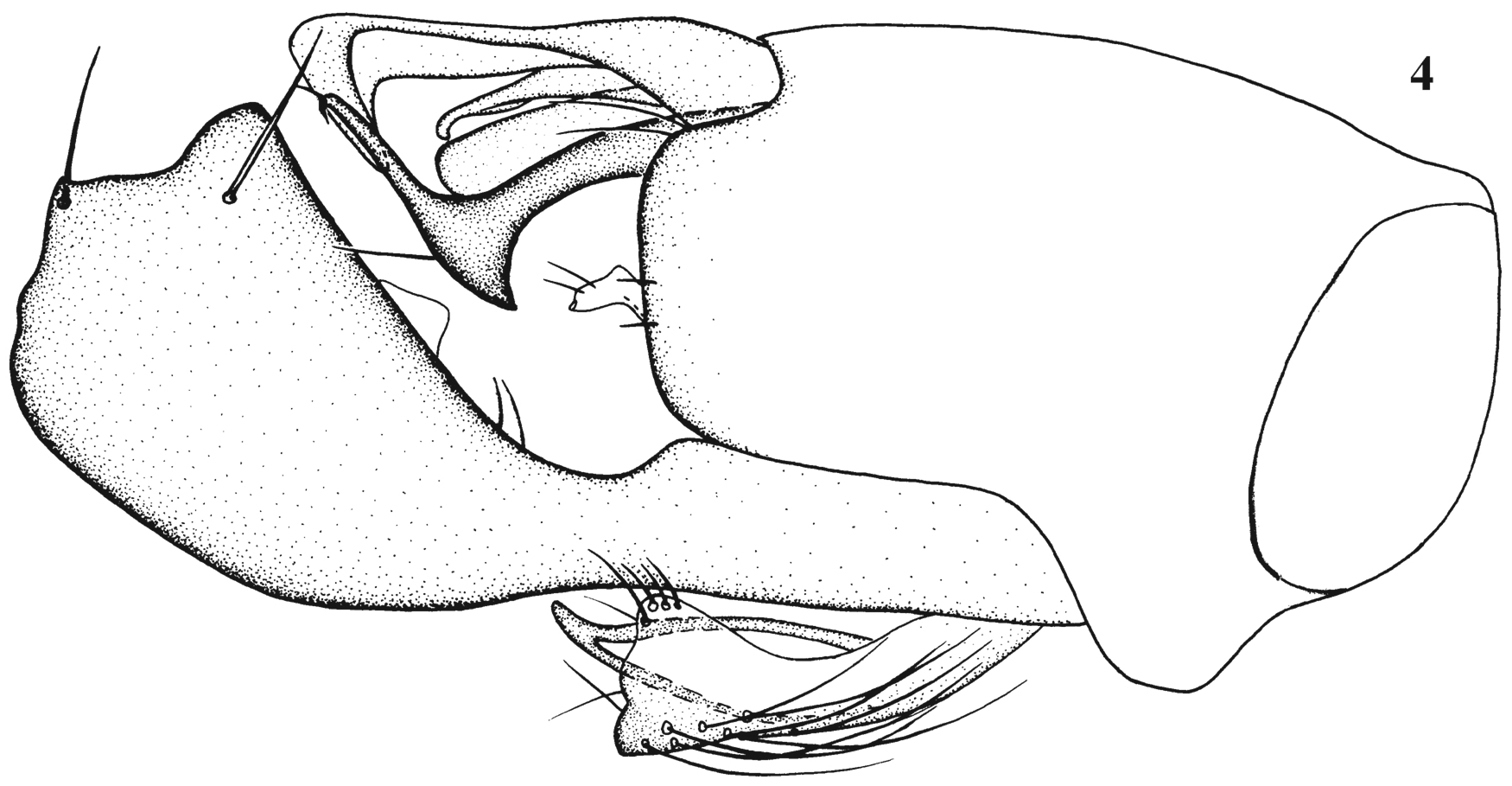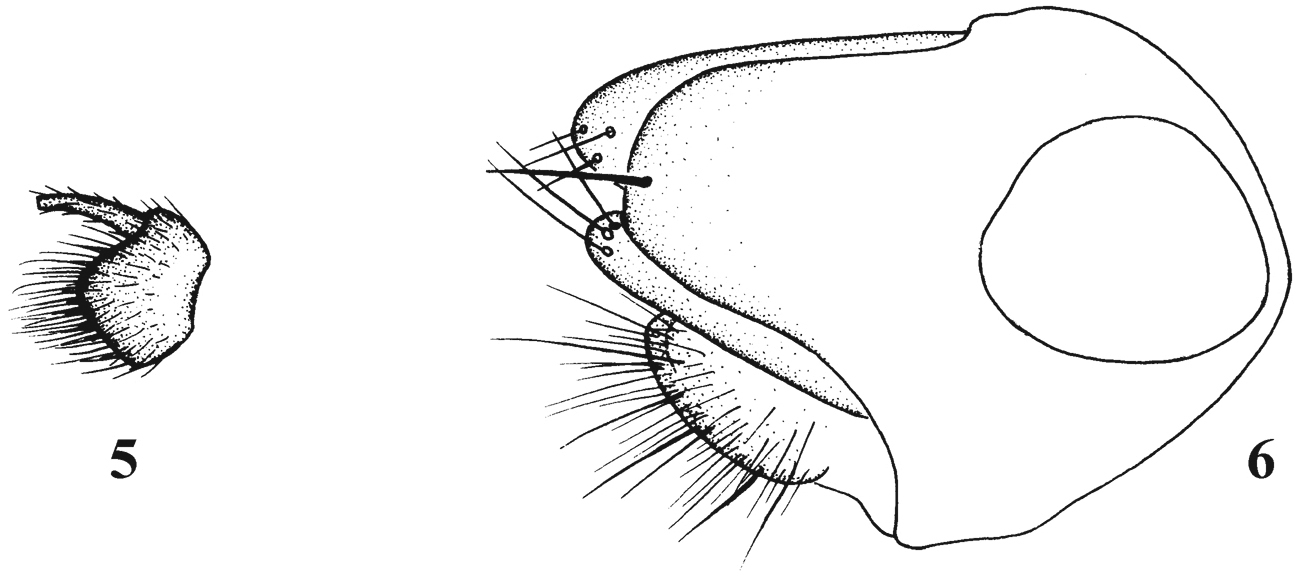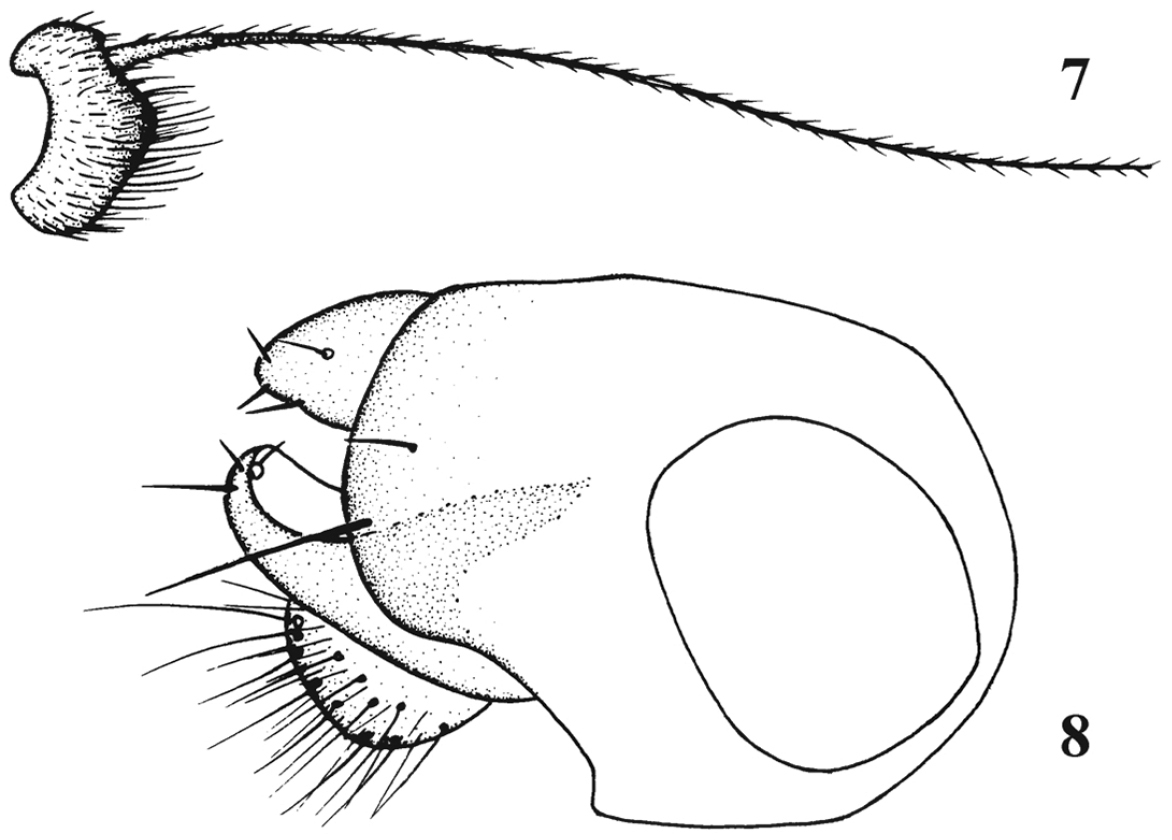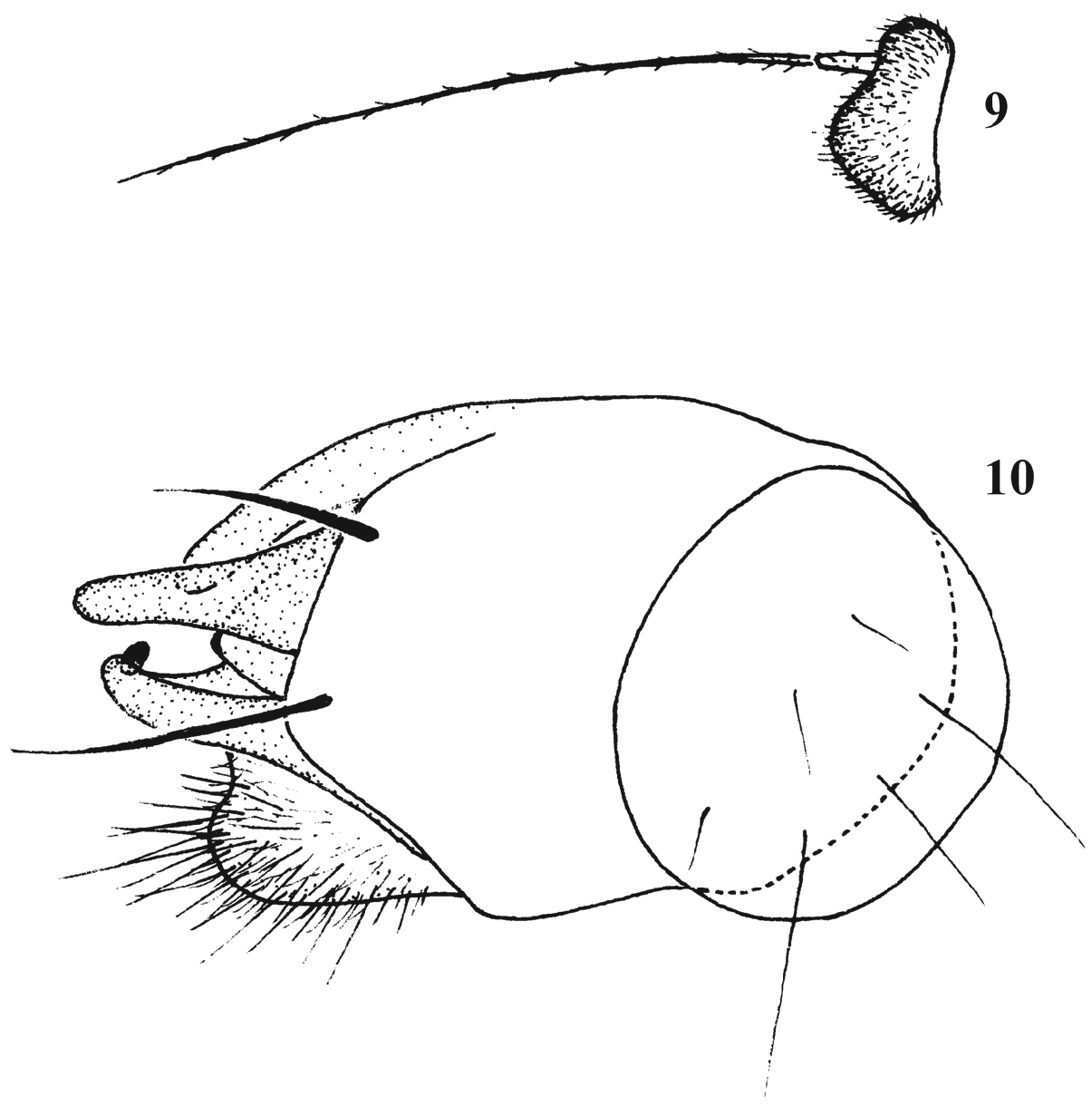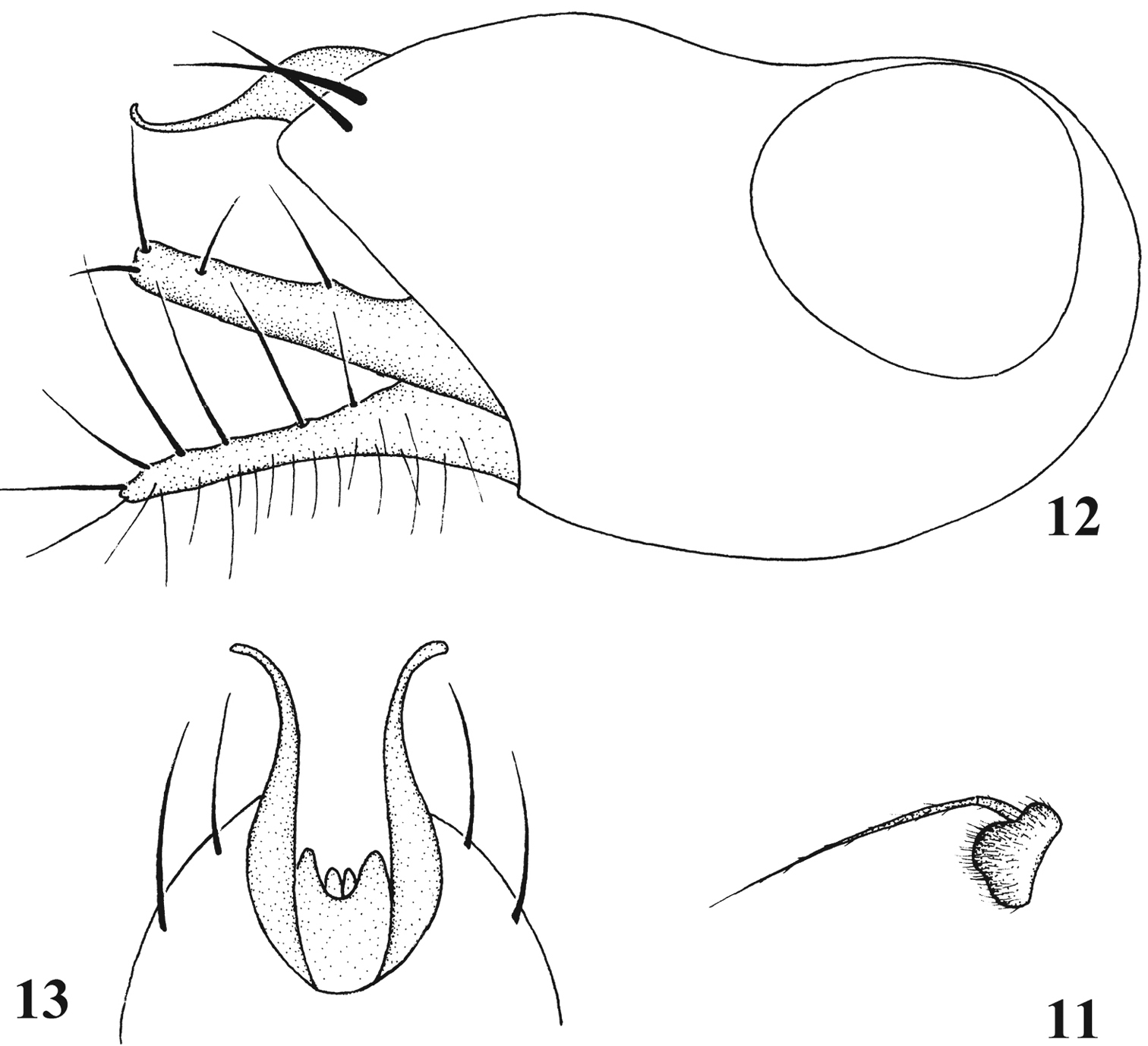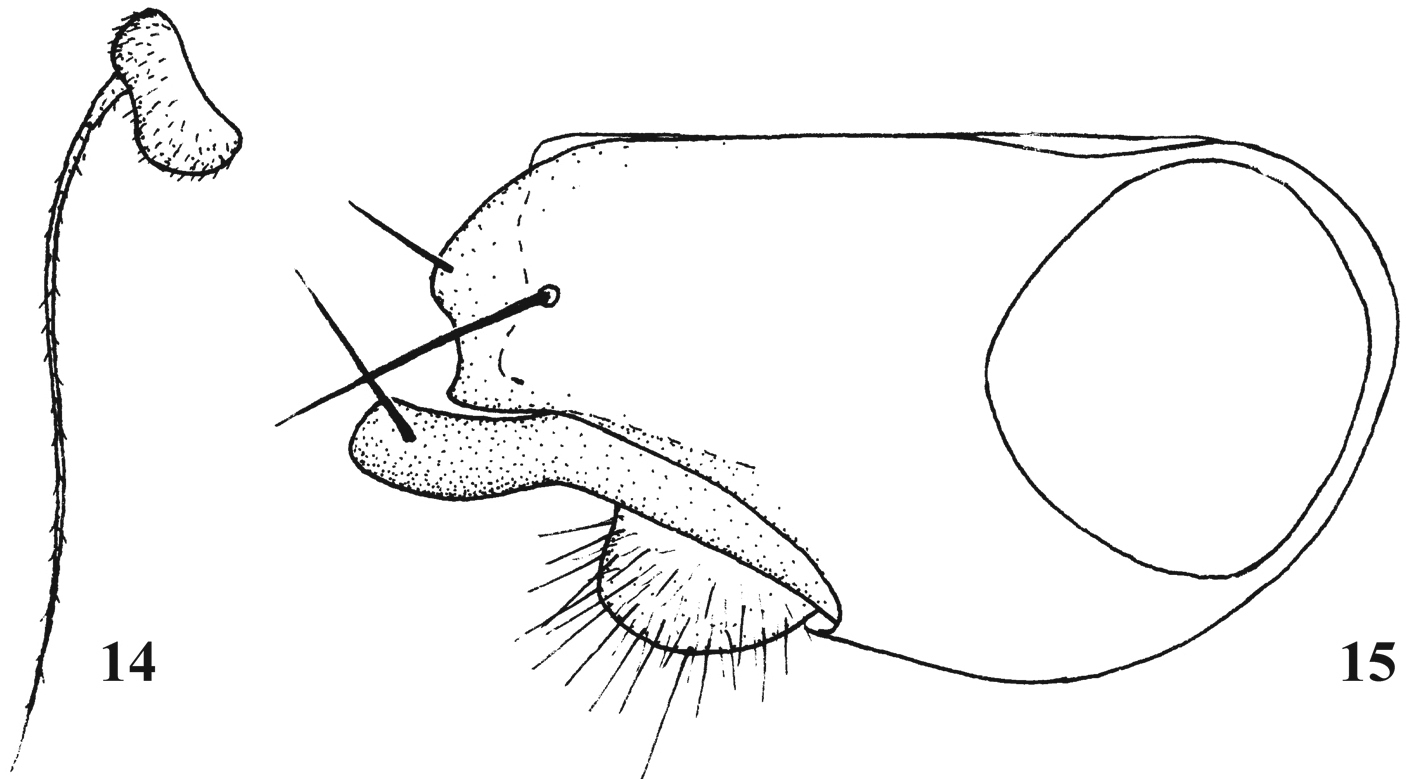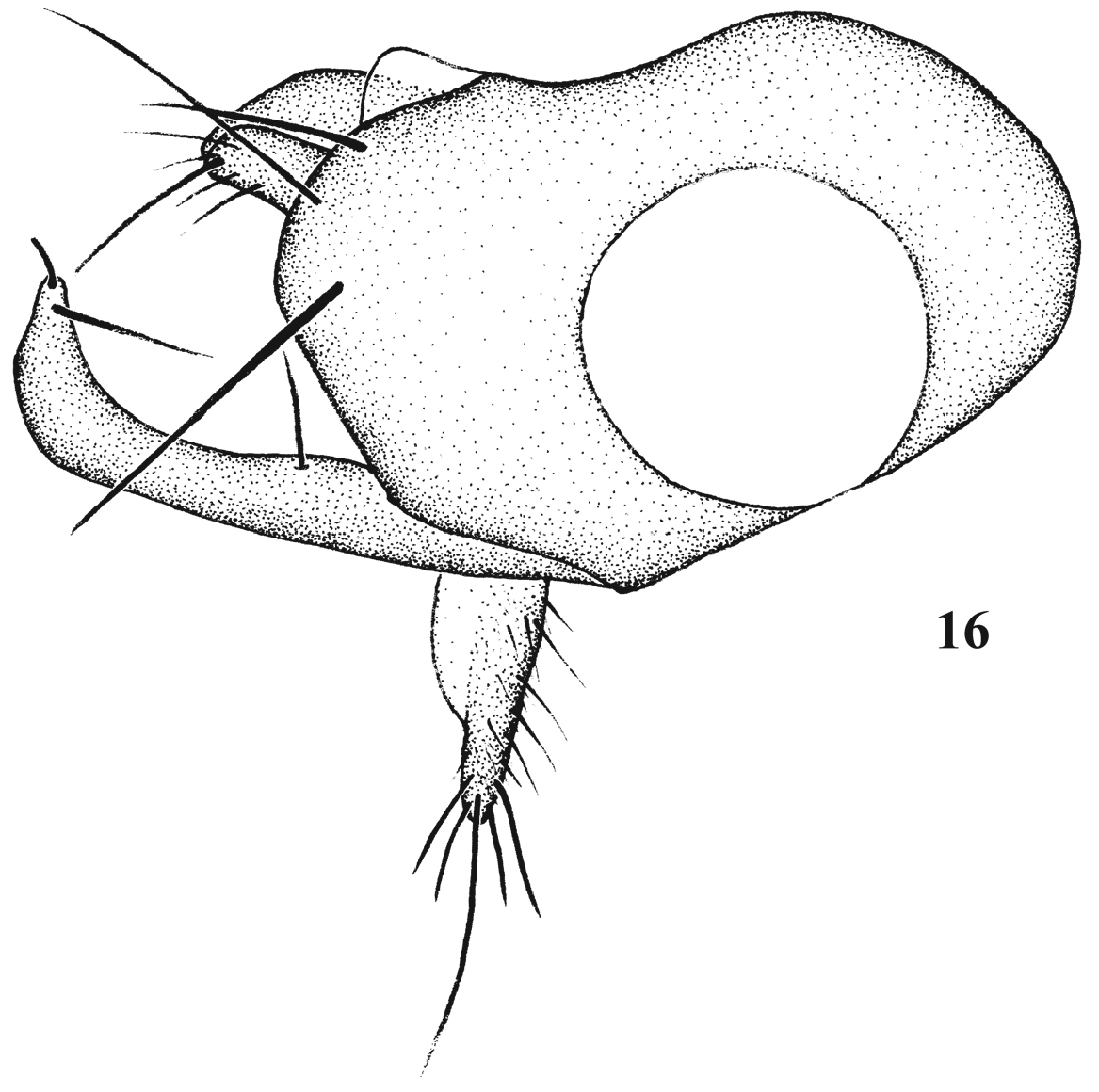






Citation: Wang M, Chen H, Yang D (2014) Review of the genus Chrysotimus Loew from Tibet (Diptera, Dolichopodidae). ZooKeys 424: 117–130. doi: 10.3897/zookeys.424.7562
A review of the species of the genus Chrysotimus from Tibet is provided. The following four species are described as new to science: C. motuoensis sp. n., C. tibetensis sp. n., C. xuankuni sp. n., C. zhui sp. n. A key to the eight Tibetan species is presented.
Diptera, Dolichopodidae, Chrysotimus, review, new species, Tibet, Taxonomy
The genus Chrysotimus Loew, 1857 belongs to the subfamily Peloropeodinae with following characters: often yellow or yellowish hairs and bristles, small first flagellomere, posterior mesonotum distinctly flattened, wing length usually distinctly longer than body length, femora II and III each with strong anterior preapical bristles, most males with hind tarsomere 1 bearing several short black ventral bristles at base, and males with mid tarsomere 1 at least as long as the total of corresponding tarsomeres 2-4, hypopygium with 1-2 epandrial bristles (not processes) for most Chinese species. The genus is distributed worldwide except for the Afrotropical region with 70 known species, of which 14 species are known from the Palaearctic (
Tibet, together with the Qinghai-Xizang Plateau, Hengduan Mountains, the Himalayas and the Yarlung Zangbo River, is considered to be the one of the most active geological regions and the most sensitive and richest regions in biological diversity in Southeast Asia. Furthermore, southeastern Tibet, bordered by tropical and monsoon rainforest, provides diverse habitats for numerous Oriental insect species, a large number of which are endemic to this area. So, it is likely that more Dolichopodidae and other dipterans will be discovered in the future in this area.
All the specimens in this study were collected from the Oriental part of southeastern Tibet. Four new species are described and a key to the species of Chrysotimus from Tibet is presented.
Specimens were studied and illustrated with a ZEISS Stemi 2000–c stereo microscope. Genitalic preparations were made by macerating the apical portion of the abdomen in warm 10% NaOH for 17–20 min. After examination and drawing the hypopygium, it was transferred to 75% alcohol and stored in a microvial pinned below the specimen. All specimens are deposited in the Entomological Museum of China Agricultural University (EMCAU), Beijing, China.
acr acrostichal bristles
ad anterodorsal bristles
av anteroventral bristles
d dorsal bristles
dc dorsocentral bristles
LI fore leg
LII mid leg
LIII hind leg
oc ocellar bristles
pd posterodorsal bristles
pv posteroventral bristles
v ventral bristles
CuAx ratio length of m-cu / length of distal portion of CuA
| 1 | Hypopygium large (about as long as half of abdomen in length) | Chrysotimus grandis Wang & Yang |
| – | Hypopygium small (normal) | 2 |
| 2 | Tarsomere III1 without black ventral bristles at base | Chrysotimus motuoensis sp. n. |
| – | Tarsomere III1 with black ventral bristles at base | 3 |
| 3 | First flagellomere as long as wide (Fig. 5) | 4 |
| – | First flagellomere shorter than 2/3 width (Figs 2, 7, 11, 14) | 5 |
| 4 | Nine to ten irregularly paired acr; tarsomere III1 with 2 black ventral bristles at base; cercus long with basal part wide (Fig. 16) | Chrysotimus zhui sp. n. |
| – | Three to four irregularly paired acr; tarsomere III1 with 10-11 black ventral bristles on basal 1/6; cercus short and round in lateral view (Fig. 6) | Chrysotimus lii Wang & Yang |
| 5 | Acr 3-4 paired; cercus round in lateral view (Figs 8, 15) | 6 |
| – | Acr more than 5 pairs; cercus not round in lateral view (Figs 3, 12) | 7 |
| 6 | Tarsomere III1 with more than 10 black ventral bristles on basal 1/6; epandrium with wide lateral process (Fig. 8) | Chrysotimus linzhiensis Wang & Yang |
| – | Tarsomere III1 with 5–6 black ventral bristles at base; epandrium without distinct lateral process (Fig. 15) | Chrysotimus xuankuni sp. n. |
| 7 | Tarsomere II1 longer than total length of tarsomere II2-5; Tarsomere III1 with 4-6 black ventral bristles at base; cercus long and thick with long bristles (Fig. 12) | Chrysotimus tibetensis sp. n. |
| – | Tarsomere II1 shorter than total length of tarsomere II2-5; Tarsomere III1 with 10–12 black ventral bristles on basal 1/5; cercus short and bifurcated (Fig. 3) | Chrysotimus bifurcatus Wang & Yang |
All coxae yellow. 6-7 irregularly paired acr short and hair-like. Tarsomere III1 with group of 10–12 short black ventral bristles on basal 1/5, and row of 8-9 pv. Cercus bifurcated. For a full description of this species, see
Chrysotimus bifurcatus Wang & Yang, 2006, male. 1 wing 2 first flagellomere, lateral view 3 hypopygium, lateral view. C cercus; E epandrium; EL epandrial lobe; Su surstylus.
Type holotype, ♂, Tibet: Bomi, alt. 3050m, 1978.VII.16, leg. Fasheng Li. This specimen was collected from the subtropical rainforest with a sweep net and is deposited in EMCAU.
Tibet (Bomi).
Palpus blackish. 6 strong dc, 6-7 irregularly paired acr short and hair-like. Tarsomere II1 longer than the total length of tarsomeres II2-5. Surstylus with large swollen apex. For a full description of this species, see
Chrysotimus grandis Wang & Yang, 2006, male, hypopygium, lateral view.
Type holotype, ♂, Tibet: Bomi, alt. 3700m, 1978.VIII.12, leg. Fasheng Li. This specimen was collected from the subtropical rainforest with a sweep net and is deposited in EMCAU.
Tibet (Bomi).
First flagellomere subtriangular, as long as wide. Tarsomere III1 with group of 10–11 short black ventral bristles on basal 1/6. For a full description of this species, see
Chrysotimus lii Wang & Yang, 2006, male. 5 first flagellomere (arista broken); lateral view 6 hypopygium, lateral view.
Type holotype, ♂, Tibet: Bomi, alt. 3050m, 1978.VII.16, leg. Fasheng Li. Paratypes, 2 ♂♂, Tibet: Linzhi, 1978. VI.1-3, leg. Fasheng Li. These specimens were collected from the subtropical rainforest with a sweep net and are deposited in EMCAU.
Tibet (Bomi, Linzhi).
Palpus pale yellow. First flagellomere short, about 1.5 times wider than long. Tarsomere III1 with group of about 13 short black ventral bristles on basal 1/6. For a full description of this species, see
Chrysotimus linzhiensis Wang & Yang, 2006, male. 7 first flagellomere, lateral view 8 hypopygium, lateral view.
Type holotype, ♂, Tibet: Linzhi, alt. 3050m, 1978.VI.1-3, leg. Fasheng Li. This specimen was collected from the monsoon rainforest with a sweep net and is deposited in EMCAU.
Tibet (Linzhi).
Antenna yellow, with both pedicel and 1st flagellomere both with brown dorsal surface; acr absent; abdomen with tergites brilliantly metallic green dorsally and yellow laterally, and with yellow sternites; tarsomere III1 without black ventral spine-like bristles at base.
Male. Body length 1.9 mm, wing length 1.9 mm.
Head metallic green with gray pollen; frons and face brilliant; eyes separated distinctly; face wide and slightly narrower towards clypeus. Hairs and bristles yellow. Ocellar tubercle weak, with 2 very long oc and 2 very short posterior hairs. Lower postocular bristles (including ventral hairs) pale. Antenna yellow, with both pedicel and 1st flagellomere with brown dorsal surface; first flagellomere (Fig. 9) rather short, about 0.6 times as long as wide; arista apical, with basal segment very short. Proboscis brown, with pale hairs; palpus pale yellow, with pale hairs and 2 brown apical bristles.
Chrysotimus motuoensis sp. n., male. 9 first flagellomere, lateral view 10 hypopygium, lateral view.
Thorax metallic green with pale gray pollen, with pleura yellow. Hairs and bristles yellow; 6 dc, acr absent; scutellum with 2 pairs of bristles. Propleuron with 1 pale bristle on lower part. Legs including coxae yellow with 5th tarsomeres brown. Hairs and bristles on legs pale yellow; coxa I with 3-4 anterior and apical bristles, coxa II with 2 anterior and apical bristles, coxa III with 1 brown outer bristle near middle. Femora II and III each with 1 apical av. Tibia II with 2 ad and 2 pd, apically with 3 bristles; tibia III with 1 ad and 2 pd, apically with 3 bristles. All tarsomere 1 each with row of v. Tarsomere III 1 without black ventral spine-like bristles at base. Relative lengths of tibia and 5 tarsomeres of legs. LI 3.4 : 2.2 : 1.0 : 0.8 : 0.6 : 0.4; LII 4.0 : 2.4 : 1.1 : 0.9 : 0.5 : 0.4; LIII 4.7 : 1.0 : 1.4 : 0.9 : 0.6 : 0.4.
Wing hyaline; veins brownish, R4+5 and M parallel apically; CuAx ratio 0.3. Squama brown with brown hairs. Halter pale yellow.
Abdomen metallic green with pale gray pollen, tergites brilliant, sternites and lateral portion yellow. Hairs and bristles on tergites dark brown, and pale yellow on sternites.
Hypopygium (Fig. 10): Epandrium with truncate apex bearing 2 epandrial bristles, apically with wide lateral epandrial process; long surstylus with inner spine-like process; cercus somewhat round, with moderately long hairs; hypandrium with round apex.
Female. Body length 1.8 mm, wing length 1.7 mm. Similar to male, but antenna entirely yellow.
Holotype ♂, Tibet: Motuo county, alt. 1100m, 2012.VIII.26, leg. Xuankun Li. Paratype, 1 ♀ same data as holotype. These specimens were collected from the subtropical rainforest with a sweep net and are deposited in EMCAU.
Known only from the type locality in Tibet.
This new species is similar to Chrysotimus guangxiensis Yang & Saigusa, but may be separated from the latter by brown proboscis, pale yellow palpus, and the tergites metallic green, sternites and lateral portion yellow. In guangxiensis, it has yellow proboscis, brown palpus, and whole abdomen metallic green (
The specific epithet derives from the type locality Motuo (Tibet).
Antenna whole brown; acr 5–6 irregular pairs; abdomen whole brilliant metallic green; tarsomere III1 with 4–6 short black ventral bristles at base; cercus long and thick, with sparse hairs and long bristles.
Male. Body length 1.7–1.8 mm, wing length 2.2–2.5 mm.
Head metallic green with gray pollen; frons and face brilliant; eyes separated distinctly. Hairs and bristles on head yellow. Ocellar tubercle weak, with 2 very long oc and 2 very short posterior hairs. Lower postocular bristles (including ventral hairs) pale. Antenna (Fig. 11) brown; first flagellomere with round apex, rather short, about 0.6 times as long as wide; arista dorsal, with basal segment very short. Proboscis brown, with pale hairs; palpus pale yellow, with pale hairs and 2 brown apical bristles.
Chrysotimus tibetensis sp. n., male. 11 first flagellomere, lateral view 12 genitalia, lateral view 13 tip of hypopygium, ventral view.
Thorax metallic green with pale gray pollen, mesonotum and scutellum brilliant. Hairs and bristles on thorax yellow; 6 dc, 5–6 irregular paired acr; scutellum with 2 pairs of bristles. Propleuron with 1 pale bristle on lower portion. Legs including coxae yellow with 5th tarsomeres brown (some specimens with black legs, except for yellow femoral base and tip). Hairs and bristles on legs pale yellow; coxa I with 2-4 anterior and apical bristles, coxa II with 3-4 anterior and apical bristles, coxa III with 1 brown outer bristle near middle. Femur II with 1 av and 1 pv apically, femur III with 1 av apically. Tibia II with 2 ad and 1 pd, apically with 3 bristles; tibia III with 2 ad, 2 pd, and row of pv, apically with 3 bristles. All tarsomere 1 each with row of v. Tarsomere III1 with 4-6 short black ventral bristles at base. Relative lengths of tibia and 5 tarsomeres of legs. LI 4.2 : 2.4 : 1.2 : 1.0 : 0.6 : 0.4; LII 5.6 : 3.2 : 1.2 : 0.8 : 0.5 : 0.4; LIII 6.4 : 2.8 : 1.6 : 1.2 : 0.8 : 0.6.
Wing hyaline; veins brownish, R4+5 and M parallel apically; CuAx ratio 0.27. Squama yellow with pale hairs. Halter pale yellow.
Abdomen metallic green with pale gray pollen, tergites and sternites brilliant. Hairs and bristles on tergites dark brown.
Hypopygium (Figs 12–13): Epandrium with acute apex, apically with 2 epandrial bristles and wide lateral epandrial process, bearing thin and curved apex; long and thick surstylus with long bristles; cercus long and thick, with sparse hairs and long bristles; hypandrium shorter than epandrium.
Female. Body length 1.5–1.7 mm, wing length 1.9–2.0 mm. Similar to male, with whole abdomen metallic green.
Holotype ♂, Tibet: Linzhi, 2012. IX.2–12 (M). Paratypes, 32♂♂ 14♀♀, same data as holotype. Other specimens: 1♂4♀♀, Tibet: Linzhi, 2012.VIII (M); 3♂32♀♀, Tibet: Linzhi, 2012. IX.22–X.1 (M); 12♂♂7♀♀, Tibet: Linzhi Sejila Mountain, alt. 3810m, 2012.VIII.25–IX.2 (M); 4♂♂11♀♀, Tibet: Linzhi Sejila Mountain, alt. 3260m, 2012.VIII.12–18 (M); 3♂♂2♀♀, Tibet: Linzhi Sejila Mountain Lulangdong, alt. 3349m, 2012.VIII.25–IX. 2 (M); 7♂♂15♀♀, Tibet: Linzhi Sejila Mountain Lulangdong, alt. 3312m, 2012.VIII.18–25 (M); 8♂♂, Tibet: Linzhi Sejila Mountain Kouxi, alt. 3780m, 2012.VIII.15–18 (M); 18♂♂13♀♀, same site, 2012.VIII.19–25 (M); 5♂♂11♀♀, Tibet: Linzhi Nongmuxueyuan Dianzhan, alt. 3573m, 2012.VII.7–15 (M), all leg. Chaodong Zhu. These specimens were collected from the monsoon rainforest with Malaise traps and are deposited in EMCAU.
Known only from the type locality in Tibet.
This new species is similar to Chrysotimus ningxianus Wang, Yang & Grootaert, but may be separated from the latter by rounded first flagellomere, and the epandrium with 1 lateral epandrial process. In ningxianus, it has triangular first flagellomere, and the epandrium has 2 lateral epandrial processes (
The specific epithet derives from the type locality in Tibet.
Antenna blackish; first flagellomere rather short, about 0.4 times as long as wide; ac 3–4 irregular pairs; tibia I with row of 8–9 d; abdomen whole brilliant metallic green; tarsomere III1 with 5–6 short black ventral bristles at base; epandrium without distinct lateral process; cercus round, with moderate hairs.
Male. Body length 1.5 mm, Wing length 1.6 mm.
Head metallic green with gray pollen; frons and face brilliant; eyes separated distinctly. Hairs and bristles on head yellow. Ocellar tubercle weak, with 2 very long oc and 2 very short posterior hairs. Lower postocular bristles (including ventral hairs) pale. Antenna blackish; first flagellomere (Fig. 14) rather short, about 0.4 times as long as wide; arista dorsal, with basal segment very short. Proboscis blackish, with brown hairs; palpus brown, with brown hairs and 2 brown apical bristles.
Chrysotimus xuankuni sp. n., male. 14 first flagellomere, lateral view 15 genitalia, lateral view.
Thorax metallic green with pale gray pollen, mesonotum and scutellum brilliant. Hairs and bristles on thorax yellow; 6 dc, 3-4 irregular paired acr; scutellum with 2 pairs of bristles. Propleuron with 1 pale bristle on lower portion. Legs including coxae yellow with 5th tarsomeres brown. Hairs and bristles on legs pale yellow; coxa I with 3–4 anterior and apical bristles, coxa II with 3–4 anterior and apical bristles, coxa III with 1 brown outer bristle near middle. Femora II and III each with 1 av apically. Tibia I with row of 8–9 d; tibia II with 2 ad and 2 pd, apically with 3 bristles; tibia III with 1 ad, 2 pd, apically with 3 bristles. All tarsomere 1 each with row of v. Tarsomere III1 with 5–6 short black ventral bristles at base. Relative lengths of tibia and 5 tarsomeres of legs. LI 4.2 : 2.0 : 1.0 : 0.8 : 0.6 : 0.6; LII 5.2 : 2.4 : 1.6 : 1.2 : 0.6 : 0.6; LIII 5.2 : 1.4 : 1.4 : 0.8 : 0.6 : 0.6.
Wing hyaline; veins brownish, R4+5 and M parallel apically; CuAx ratio 0.28. Squama yellow with pale hairs. Halter brownish.
Abdomen metallic green with pale gray pollen, tergites and sternites brilliant. Hairs and bristles on abdomen dorsal dark brown.
Hypopygium (Fig. 15): Epandrium with wide apex, apically with invision, bearing 2 epandrial bristles, but no distinct lateral epandrial process; long and thick surstylus with curved apex; cercus round, with moderate hairs; hypandrium shorter than epandrium.
Body length 1.5–1.6 mm, Wing length 1.5–1.6 mm. Similar to male, with whole abdomen metallic green.
Holotype ♂, Tibet: Motuo county, alt. 1100m, 2012. VII. 26, leg. Xuankun Li. Paratype, 2♀♀, same data as holotype. These specimens were collected from the subtropical rainforest with a sweep net and are deposited in EMCAU.
Known only from the type locality in Tibet.
This new species is similar to Chrysotimus guangdongensis Wang, Yang & Grootaert, but may be separated from the latter by the rowed d on tibia I, and the epandrium bearing no distinct lateral process. In guangdongensis, it lacks distinct rowed d on tibia I, and features a lateral process of the epandrium (
The specific epithet derives from the collector of type species Xuankun Li.
Antenna brown; first flagellomere subtriangular, about as long as wide; acr 9–10 irregular pairs; tarsomere III1 with 2 short black ventral bristles on long kidney-shaped black spot; abdominal dorsum brilliant metallic green; epandrium with long and curved surstylus; cercus long with wide basal part, with long hairs and bristles.
Male. Body length 1.9–2.0 mm, Wing length 2.2–2.4 mm.
Head metallic green with gray pollen; frons and face brilliant; eyes separated distinctly. Hairs and bristles on head yellow. Ocellar tubercle weak, with 2 very long oc and 2 very short posterior hairs. Lower postocular bristles (including ventral hairs) pale. Antenna brown; first flagellomere subtriangular, about as long as wide; arista dorsal, with basal segment very short. Proboscis blackish, with brown hairs; palpus yellow, with yellow hairs and 2 brownish apical bristles.
Thorax metallic green with pale gray pollen, mesonotum and scutellum brilliant. Hairs and bristles on thorax yellow; 6 dc, 9–10 irregular paired acr; scutellum with 2 pairs of bristles. Propleuron with 1 pale bristle on lower portion. Legs including coxae yellow with 5th tarsomeres brown. Hairs and bristles on legs pale yellow; coxa I with 3–4 anterior and apical bristles, coxa II with 4–6 anterior and apical bristles, coxa III with 1 brown outer bristle near middle. Femur II with 1 av and 1 pv apically, femur III with 1 av apically. Tibia II with 2 ad and 2 pd, apically with 3 bristles; tibia III with 2 ad, 2 pd, and row of pv, apically with 3 bristles. All tarsomere 1 each with row of v. Tarsomere III1 with long kidney-shaped black spot at base, with 2 short black ventral bristles at black spot. Relative lengths of tibia and 5 tarsomeres of legs. LI 4.4 : 2.8 : 1.0 : 0.8 : 0.5 : 0.5; LII 6.0 : 3.6 : 1.4 : 1.0 : 0.6 : 0.6; LIII 6.4 : 2.0 : 1.4 : 1.0 : 0.7 : 0.6.
Wing hyaline; veins brownish, R4+5 and M parallel apically; CuAx ratio 0.25. Squama yellow with pale hairs. Halter pale yellow.
Abdomen metallic green with pale gray pollen, tergites brilliant. Hairs and bristles on abdomen dorsal dark brown.
Hypopygium (Fig. 16) metallic green (except pale hypandrium): Epandrium distinctly longer than wide, apically with 3 epandrial bristles and round short finger-like lateral epandrial process; long and curved surstylus with long bristles; cercus long with wide basal part, with long hairs and bristles; hypandrium short, pale.
Chrysotimus zhui sp. n., male. hypopygium, lateral view.
Body length 2.0 mm, Wing length 2.8 mm. Similar to male, with whole abdomen metallic green.
Holotype ♂, Tibet: Linzhi Sejila Mountain Kouxi, alt. 3780m, 2012. VIII. 15–18 (M), leg. Chaodong Zhu; Paratype, 1♂ 1♀, same data as holotype. These specimens were collected from the monsoon rainforest with a Malaise trap and are deposited in EMCAU.
Known only from the type locality in Tibet.
This new species is similar to Chrysotimus ningxianus Wang, Yang & Grootaert, but may be separated from the latter by the black spot at tarsomere III1 base, and the epandrium with 1 single finger-like lateral epandrial process. In ningxianus, it has no black spot at tarsomere III1 base, and the epandrium has 2 lateral epandrial processes (
The specific epithet derives from the collector of types Dr. Chaodong Zhu (Beijing).
We are very grateful to Dr. Xuankun Li (CAU, Beijing), Dr. Fasheng Li (CAU, Beijing), and Dr. Chaodong Zhu (Institute of Zoology, Chinese Academy of Science, Beijing) for collecting the specimens and help in many ways. This research is partly supported by the Key Project of Chinese National Programs for Fundamental Research and Development (973 Program No. 2013CB127602), the Special Fund for Agro-scientific Research in the Public Interest of China (No. 201103002) and the Sino-America Biocontrol International Cooperation Program (No. 58-4001-4-053).
